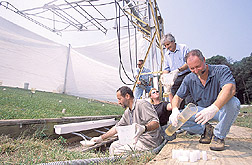This page has been archived and is being provided for reference purposes only. The page is no longer being updated, and therefore, links on the page may be invalid.
|
Read the magazine story to find out more. |
Making Manure-Borne Pathogens Stay PutBy Sharon DurhamOctober 22, 2002 By filtering out pathogens in manure, grass buffer strips may be a useful tool to prevent these organisms from washing into surface water from farmland runoff, Agricultural Research Service scientists report. Microbiologist Daniel R. Shelton and his colleagues at the ARS Animal Waste Pathogen Laboratory in Beltsville, Md., are conducting a study in collaboration with University of Maryland scientist Adel Shirmohammadi to determine how effectively grass buffer strips filter out pathogens. Shelton's group constructed oddly slanted hills to simulate different topographies bordering farm areas. The scientists planted grass strips on two 20-foot-long, slanted slopes of a wedge-shaped, aboveground mound. One slope had a clay loam soil, while another was covered with sandy loam. Various indigenous grasses were planted on each soil type to test the filtering effect. Bare slopes devoid of vegetation were used as controls. The researchers applied fresh dairy-barn manure along the top of the slopes, then used overhead sprinklers to simulate rainfall. Collection tubes were placed at various points on the slopes to funnel samples of runoff water to be analyzed for bacteria content. Runoff from the bare clay loam slope contained virtually all of the pathogens present in the manure. Sandy loam soil fared better: 75 percent of the pathogens remained in the sandy loam slopes. Sand enables water and microbes to move into the soil more quickly, rather than run off the surface. By contrast, vegetated slopes held on to practically all of the pathogens, leaving none in the runoff water from the sandy loam soil, and only 0.6 percent in the runoff water from the clay loam soil. Pathogens that remain in the soil either become food for other soil organisms, or they settle into an area between soil layers that doesn't support life. A more detailed story appears in the October 2002 issue of Agricultural Research magazine. /is/AR/archive/oct02/manure1002.htm ARS is the chief scientific research agency of the U.S. Department of Agriculture. |

